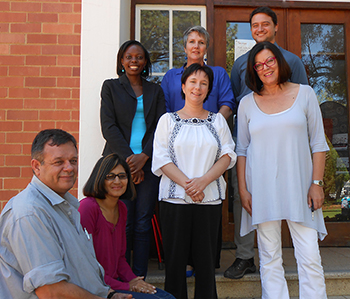Latest News Archive
Please select Category, Year, and then Month to display items
22 September 2021
|
Story Michelle Nöthling
|
Photo Supplied
 Annemarie Le Roux.
Annemarie Le Roux.
“I love working with children.” This is one of the first things Annemarie le Roux mentions when asked to describe herself. This love for children propelled Annemarie into the field of education and she graduated in 2006 with a BEd in Foundation Phase at the UFS. Annemarie immediately immersed herself in the Deaf community, enriching the lives of children at the Thiboloha School for the Deaf in Qwaqwa and the De la Bat School for the Deaf in Worcester.
The academic world enticed Annemarie back to the University of the Free State (UFS) and she was appointed as a junior lecturer in the Department of South African Sign Language (SASL) and Deaf Studies in 2013. Going from strength to strength, Annemarie completed her master’s degree in SASL in 2019, and published an
article earlier this year that she co-wrote with Marga Stander. In this article, they found that SASL “has become an increasingly popular language that hearing university students want to learn as a second language” and subsequently explored different teaching methods used for this emerging group of interested students.
Although now firmly established in academia, Annemarie is still committed to the practical application of SASL. “I am closely involved in student and community engagement through the
SIGNALS Sign Language student association that helps empower the Deaf community and South African Sign Language.” She also interprets for the Deaf community whenever she gets an opportunity, as well as for Deaf students in class and meetings.
On the importance of Sign Language and the recognition of the Deaf community in South Africa, Annemarie believes it will open greater opportunities for development. “More people will be able to learn SASL, and it might even become a subject in school for hearing children.”
Fighting the tuberculosis battle as a collective
2015-09-28

The team hard at work making South Africa a
healthier place |
Tuberculosis (TB) is second only to HIV/AIDS as the greatest killer worldwide due to a single infectious agent. More than 95% of TB deaths occur in low- and middle-income countries. Despite being more prevalent among men than women, TB remains one of the top five causes of death amongst women between the ages of 15 and 44 years. While everyone is at risk for contracting TB, those most at risk include children under the age of five and the elderly. In addition, research indicates that individuals with compromised immune systems, household contacts with pulmonary TB patients, and healthcare workers are also at increased risk for contracting TB.
According to the Deputy Director of the Centre for Health Systems Research and Development (CHSR&D) at the UFS, Dr Michelle Engelbrecht, research has found that healthcare workers may be three times more likely to be infected by TB than the general population.
The unsettling fact
“Research done in health facilities in South Africa has found that nurses do not often participate in basic prevention acts, such as opening windows and wearing respirators when attending to infectious TB patients,” she explained.
In response to this concern, CHSR&D, which operates within the Faculty of Humanities at the the University of the Free State (UFS) Bloemfontein Campus has developed a research project to investigate TB prevention and infection control in primary healthcare facilities and households in Mangaung Metropolitan.
Action to counter the statistics
A team of four researchers and eight field workers from CHSR&D are in the process of gathering baseline data from the 41 primary healthcare facilities in Mangaung. The baseline comprises a facility assessment conducted with the TB nurse, and observations at each of the facilities. Individual interviews are also conducted with community caregivers, as well as TB and general patients. Self-administered questionnaires on knowledge, attitudes, and practices about TB infection control are completed by all nurses and facility-based community caregivers.
Healthcare workers are the main focus of this research, given their increased risk of acquiring TB in healthcare settings. At clinics, interventions will be developed to improve infection control practices by both healthcare workers and patients. TB patients’ households are also visited to screen household contacts for TB. Those found to have symptoms suggesting TB infection are referred to the clinics for further assessment and treatment.
The findings of this study will serve to inform the development of an intervention to address TB prevention and infection control in primary healthcare facilities. Further funding will be sought to implement and evaluate the intervention.
Curbing future infections and subsequent deaths as a result of TB is the priority for the UFS. The cooperation and collaboration of the community, government, and sponsors will ensure that this project is a success, hence prolonging life expectancy.